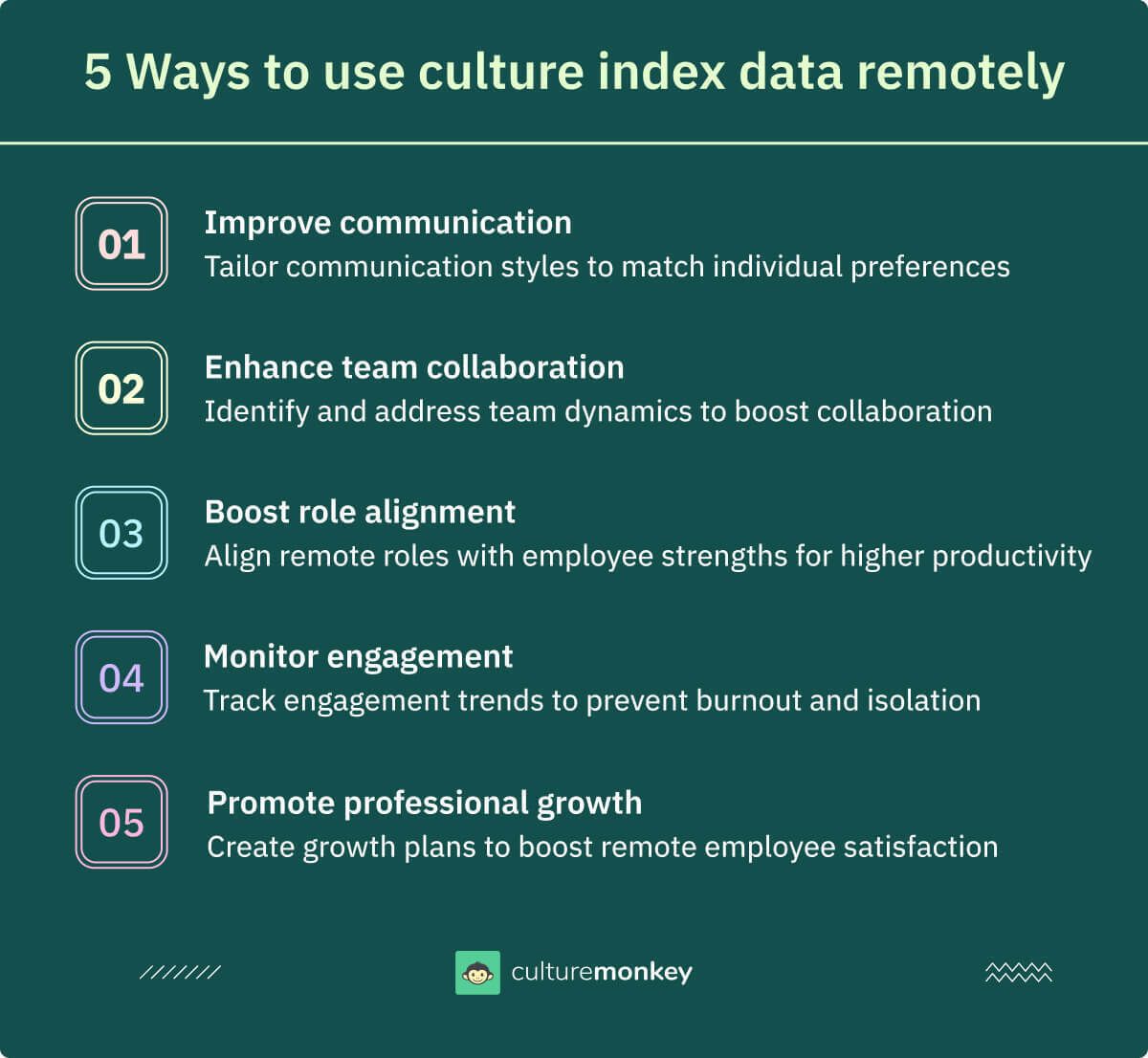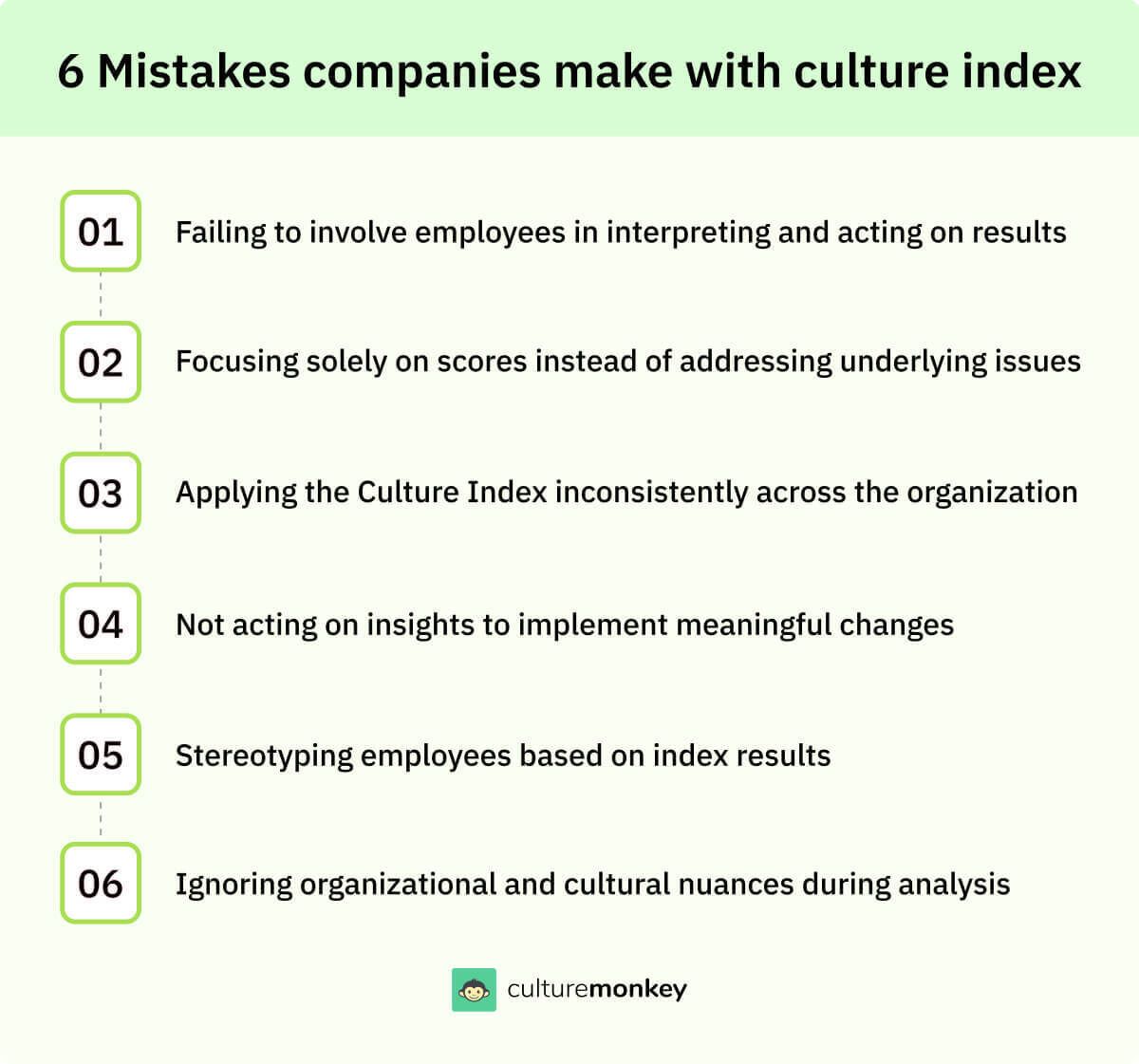50+ Culture index survey questions that you should ask your employees in 2025

Have you ever tried playing Mario Kart with a controller that’s just a little off? One minute you’re in the lead, the next you’re drifting into lava on Rainbow Road because your kart keeps veering left. You press harder, faster, more desperately—nothing works.
And of course, your friends laugh, assuming you are just bad at the game. You know you're good. But your gear is out of sync. Now, shift that feeling to leadership. You’re steering your team with the best intentions, but something feels... off. Engagement is patchy. Communication misses. Results lag behind effort.
That’s where the Culture Index comes in—it’s like handing you a finely tuned controller. It shows you how your people are wired, what motivates them, and where they need support. No more oversteering or guesswork.
Just smoother turns, better alignment, and a team that’s actually built to win. Because leadership? It’s a lot like racing—you can’t win with a broken controller.
Blog Highlights


What is a culture index?

A culture index measures how employees feel about their workplace, capturing their opinions, sentiments, and attitudes toward their roles and responsibilities. For managers, it’s crucial to assess team culture regularly to understand what influences employee morale, relationships, and sense of belonging.
This is where a culture index survey comes in. It allows organizations to gauge employee perceptions, uncover insights about their work culture, and identify areas for improvement. By analyzing key factors impacting the workforce, these surveys help illustrate how employees feel about being part of the organization and guide actionable changes to enhance company culture.
According to PWC, 67% of employers believe company culture is more critical than operations or strategy. A weak culture can lead to disengagement, impacting organizational goals. Culture index surveys address these challenges by identifying pain points, such as low engagement caused by insufficient feedback or encouragement from managers.
These surveys also categorize and assess different aspects of company culture to ensure smooth operations and alignment across teams. By leveraging culture index insights, organizations can create a more supportive and motivated workplace, enabling them to retain top talent and stay competitive in the market.



Corporate culture matters. How management chooses to treat its people impacts everything for better or for worse.
Author and public speaker
Why is the culture index important?

Creating a positive workplace culture is essential for organizational success, as it directly impacts employee engagement and retention. A culture index acts as a guiding metric to assess and improve the overall employee experience.
- Enhances employee engagement: Organizations with a strong culture index see proactive teams and happier employees. This leads to higher productivity and motivation across all levels.
- Reduces employee turnover: By identifying gaps in workplace satisfaction and addressing pain points, the culture index helps reduce turnover rates and retains top talent effectively.
- Addresses employee burnout: Measuring the culture index sheds light on factors causing burnout, such as lack of feedback or a top-down management approach, enabling targeted improvements.
- Attracts and retains top talent: A high culture index creates an environment that appeals to skilled professionals, fostering loyalty and attracting new talent who value a positive workplace.
- Improves organizational growth: A strong culture index score supports better employee retention, learning and development, and loyalty, all of which drive long-term organizational success.
- Detects early signs of cultural drift: Over time, even the most values-driven organizations can unknowingly drift from their intended culture. Regular culture index surveys help spot subtle shifts in employee sentiment and behavior, allowing for timely recalibration before issues become systemic.
- Validates the impact of leadership changes: When new leaders join or leadership styles evolve, the culture index provides concrete data on how these shifts are perceived by teams—helping organizations measure alignment, build trust faster, and refine leadership integration strategies.
What is a culture index survey?

A culture index survey is a strategic tool that evaluates employees’ perceptions of their workplace, including values, attitudes, and experiences. It goes beyond standard surveys by assessing key cultural factors like communication, inclusivity, leadership effectiveness, and alignment with organizational values.
This survey provides actionable insights to address issues such as disengagement, low morale, or high turnover. For example, it identifies hidden barriers to collaboration or trust within teams, enabling leaders to implement targeted improvements that strengthen workplace relationships.
By conducting culture index surveys periodically, organizations can track cultural shifts, measure the impact of new initiatives, and ensure alignment with employee expectations. It also sheds light on leadership transparency, fairness, and inclusivity, allowing gaps to be addressed effectively.
In essence, the culture index survey acts as a diagnostic tool, helping organizations foster a positive culture that attracts talent, retains employees, and boosts overall engagement and productivity.
What is a culture index test?

A culture index test is a powerful assessment tool designed to evaluate how employees perceive their organization’s culture and values.
- Evaluates role and team fit: The test helps assess whether employees’ strengths and preferences align with their roles and team dynamics. This alignment fosters better collaboration and productivity.
- Highlights motivational drivers: It uncovers what truly motivates employees, whether it’s recognition, growth opportunities, or work-life balance. Leaders can use this data to design personalized engagement strategies.
- Tracks leadership impact: By measuring perceptions of leadership effectiveness, the test identifies gaps in leadership styles and their influence on team performance, enabling targeted development plans.
- Monitors cultural alignment: The test evaluates how well employees align with the organization’s mission, vision, and values. Misalignment here can indicate deeper cultural issues that need attention.
- Identifies engagement barriers: Pinpointing issues like communication breakdowns, lack of inclusivity, or inadequate resources helps organizations proactively address barriers to employee engagement.
- Supports data-driven decisions: The insights gathered enable leaders to make informed decisions about workplace improvements, ensuring interventions are both relevant and effective.
What is a Culture Index applicant survey?
The Culture Index applicant survey is a specialized tool designed to evaluate how well a potential hire aligns with a company's performance needs. Unlike traditional personality tests, this survey is built specifically for business use—providing predictive insights that support smarter hiring decisions.
At its core, the Culture Index assessment helps employers understand the behavioral traits and motivational drives of candidates. The survey typically takes less than 10 minutes to complete and uses a forced-choice format to gather data. This information is then used to identify whether the applicant fits the behavioral profile best suited for a specific role. It’s particularly useful when trying to reduce turnover, increase performance, and ensure cultural alignment.
Beyond hiring, the Culture Index system plays a broader role in organizational strategy. Through ongoing Culture Index training, leadership teams learn how to interpret results, compare team dynamics, and refine role definitions. This makes it not just a hiring tool, but a long-term asset for shaping workforce performance. When paired with culture survey questions and other tools like an organizational culture index, it becomes central to a company's talent and culture strategy.
Components of the culture index survey
These components create a structured approach to understanding workplace dynamics.
- Employee demographic data: Including demographic questions helps identify trends across various employee groups. Factors like department, tenure, or role-specific data can highlight engagement disparities and address targeted needs effectively.
- Sentiment analysis questions: Incorporate questions that gauge employee emotions about their workplace experiences. Sentiment-based questions provide qualitative insights into how employees truly feel, offering a deeper layer of understanding.
- Frequency and recurrence: A good culture index survey includes questions that can be revisited periodically. This allows companies to track progress over time and evaluate the impact of engagement initiatives.
- Role-specific insights: Tailored questions based on specific roles help uncover unique challenges or strengths across different job functions. This ensures solutions are relevant and actionable for every team.
- Open-ended questions: Allowing employees to elaborate on their experiences through open-ended questions fosters honesty and creativity, offering nuanced feedback that structured options may miss.
- Leadership perception questions: Understanding how employees view leadership effectiveness and transparency helps identify gaps in communication and trust. Strong leadership support drives overall engagement.
- Workplace flexibility and DEI&B focus: Include questions on flexibility, diversity, equity, inclusion, and belonging. These areas are crucial for modern workplace satisfaction and provide actionable insights for inclusivity.
What are the culture index categories?

Think of them as the distinct flavors that make up the recipe of your organization's culture. Just like a dish can be a blend of sweet, savory, and a hint of spice, your company's culture is a mix of various elements that create its unique taste.
Here's the scoop on these categories:
- Leadership style: It all starts at the top, doesn't it? This category delves into how your leadership team operates. Are they more hands-on, nurturing, or more focused on autonomy? This aspect shapes how decisions are made, how teams collaborate, and the overall tone of the workplace.
- Communication dynamics: Ah, the power of words! This category explores how information flows within your organization. Is it a top-down approach, or does every voice get a chance to be heard? Clear, open communication can foster trust and transparency, while the lack of it can lead to confusion and frustration.
- Team collaboration: How do your teams play together in the sandbox? Are they siloed, or do they seamlessly collaborate across departments? This category gets to the heart of how cross-functional projects and ideas come to life.
- Employee development: Every employee is on their unique journey. This category shines a light on how your organization supports professional growth. Is there ample training, mentorship, and room to learn and climb the career ladder?
- Work-life balance: Burnout or balance? This category delves into whether your organization encourages a healthy separation between work and personal life. A culture that values well-being can lead to happier, more engaged employees.
- Diversity and inclusion: Does your organization embrace the kaleidoscope of perspectives and backgrounds? This category examines how diverse your workforce is and whether inclusion is woven into the fabric of your culture.
- Innovation culture: Does your workplace nurture innovation and experimentation? This category helps you understand if employees are encouraged to think outside the box and contribute fresh ideas.
- Recognition and rewards: High-fives for a job well done! This category explores how your organization acknowledges and rewards exceptional performance. Recognition can be a powerful motivator for employees.
- Adaptability: In the whirlwind of change, how does your organization fare? This category gauges how agile and adaptable your culture is in the face of shifts and challenges.
What are culture index personality types?

Picture a movie with an ensemble of personalities, each contributing their unique flair to the narrative of your workplace.
- The drivers: These are the trailblazers who don't just follow the path – they forge it. Drivers are assertive, goal-oriented, and thrive on challenges. They're your natural-born leaders, charging forward with determination and vision.
- The analysts: Precision is their middle name. analysts have a keen eye for details and a knack for analyzing data. They bring logic and structure to the table, making them your go-to folks when intricate problem-solving is needed.
- The collaborators: It takes a village, and the collaborators are the ones who bring everyone together. They excel at teamwork, communication, and building relationships. Their ability to foster camaraderie and bridge gaps makes them indispensable connectors.
- The diplomats: Imagine a world where conflicts are resolved with finesse and empathy – that's where the diplomats shine. They're the peacemakers, skilled at diffusing tensions and ensuring harmonious interactions. Their emotional intelligence is a soothing balm in a world of differences.
- The performers: Lights, camera, action – the performers thrive in the spotlight. They're your creative souls, injecting enthusiasm and energy into every endeavor. Their charisma is infectious, making them natural motivators and influencers.
- The facilitators: Behind every smooth operation is a facilitator. They're the organizers, ensuring that processes run seamlessly. With a knack for managing resources and schedules, they keep the gears of your organization well-oiled.
- The conservers: Change may be constant, but conservers prefer stability. They value tradition, reliability, and consistency. Their steady approach ensures that your organization's foundations remain strong.
- The achievers: The name says it all – Achievers set their sights on success and won't settle for less. They're ambitious, determined, and motivated to achieve their goals. Their drive can be contagious, inspiring others to reach for the stars.
- The craftsmen: Precision meets creativity in the craftsmen. They're the ones who take pride in their workmanship, paying attention to every detail. Their dedication to quality ensures that excellence becomes the standard.
- The visionaries: Big dreams and even bigger ideas – that's where the visionaries thrive. They're innovators, always thinking ahead and imagining new possibilities. Their foresight can guide your organization toward exciting horizons.
Culture index types
By understanding these types, organizations can tailor their surveys to address targeted objectives and gain actionable insights.
- Engagement-based surveys: These surveys focus on measuring how invested employees are in their work and the organization. Questions address motivation, alignment with company goals, and willingness to go above and beyond in their roles.
- Onboarding experience surveys: Specifically designed for new hires, these surveys gather feedback on the onboarding process. They identify gaps in training, integration, and role clarity, ensuring a smoother transition for new employees.
- Pulse surveys: Pulse surveys are short and frequent, offering real-time insights into employee sentiments. They track immediate reactions to workplace changes, initiatives, or events, enabling quick course corrections.
- Leadership effectiveness surveys: These focus on evaluating leadership performance, communication, and decision-making. They highlight areas where leaders can improve to better align with employee expectations and organizational goals.
- Workplace climate surveys: Climate surveys assess the overall workplace environment, focusing on relationships, collaboration, and inclusivity. They are ideal for identifying systemic issues that impact team dynamics and morale.
- Change management surveys: Designed for periods of organizational change, these surveys gauge employee adaptability and feedback on transitions like mergers, policy shifts, or new technology adoption.
Key features of the culture index survey
The culture index survey traits consist of multiple key components that make it stand out from similar assessments. Let’ see why we you need to send culture surveys to your employees and analyze some of its key features here:
- The survey data collected through the cultural index survey results are useful in many stages of the employee life cycle, including recruiting, developing, and employee engagement as it helps you uncover hidden insights about your employee’s engagement issues and the data acts as a tool for you to check on employees.
- The questions in the cultural index survey are simple and easy to understand for the employees to provide their feedback. Also, the survey metrics derived from the feedback are easy to comprehend and actionable for a people leader.

- The survey results gathered opens the gate to a wide range of data from employees. A large quantity of data helps you analyze the workplace culture, patterns, and other key insights for further development.
- These surveys help you measure the pulse of your employees, understand their concerns accurately and solve their culture and workplace problems accurately measuring the right metrics and key drivers of employee engagement.
- The survey metrics derived from the feedback are easy to comprehend and actionable for a people leader. But what makes these insights truly valuable is their direct link to actionable steps. The survey doesn't just provide a sea of data; it guides leaders toward clear and effective actions.
- While many surveys offer a one-size-fits-all approach, the culture index survey recognizes that every organization is unique. It allows for customization to suit your specific context.
- A standout feature of the culture index survey is its capacity for longitudinal analysis. It doesn't just provide a snapshot of your organization's culture; it allows you to track changes over time. This is essential for evaluating the effectiveness of your interventions and strategies.
- More than just a data collection tool, the culture index survey fosters dialogue within your organization. It opens channels of communication between leaders and employees, allowing for open discussions about culture, values, and aspirations.
Culture Index vs. other personality assessments
When evaluating talent or optimizing team dynamics, businesses often compare the Culture Index with traditional personality tests. While they may seem similar at a glance, the Culture Index survey has distinct advantages tailored for business performance.
Unlike generic tests, the Culture Index gives companies precise insight into how candidates think, work, and lead, making it a powerful tool for performance alignment.
| Aspect | Culture Index | Traditional Personality Tests |
|---|---|---|
| Purpose | Business-focused behavioral analysis | General personality profiling |
| Core Design | Built for executive decision-making and growth | Designed for individual self-awareness |
| Question Style | Forced-choice with job-related framing | Abstract or introspective questioning |
| Output | Directly maps to business-relevant behaviors | Broad personality categorization |
| Common Use Case | Hiring process, team alignment, and leadership strategy | Personal development or therapy |
| Assessment Type | Culture Index test is strategic and data-driven | MBTI and DISC are more introspective in nature |
| Personality Typing | Defines unique Culture Index personality types | Uses standard type buckets like INTJ or "D-type" |
| Survey Format | Optimized Culture Index survey questions for workplace insight | Often static or pre-defined questionnaires |
How to decide between the culture index and another assessment?

So, how do you decide between the Culture Index and another assessment? It's like choosing the perfect tool for a specific job – you want the one that fits just right. Here's the lowdown to help you make the call.
- Consider your objectives: The Culture Index might be your best bet if you're diving deep into your organization's cultural nuances. It's tailored to understanding the intricate threads that weave your workplace culture. If you're looking for a broad snapshot of employee satisfaction or engagement, a more general assessment might do the trick.
- Scope and depth: The Culture Index is like an archaeologist's brush, delicately uncovering hidden gems. It digs deep into specific culture-related aspects. If you're seeking insights into broader areas like employee performance or customer feedback, another assessment might offer a more holistic view.
- Alignment with goals: What do you want to achieve through this assessment? If your goal is to align your culture with your business strategy, the Culture Index aligns like stars in a constellation. But if you're after something more specific, like identifying skill gaps or evaluating training needs, other assessments might suit your purpose.
- Employee feedback: Your employees' voices matter. Consider their preferences and comfort levels with the assessment format. The Culture Index involves employee feedback, which can be incredibly insightful, but if your team responds better to a different type of assessment, that's a crucial factor to weigh.
- Timing and frequency: Are you in for the long haul or a quick check-in? The Culture Index is great for periodic evaluations and tracking culture evolution. If you're looking for rapid, real-time feedback, another assessment might provide quicker results.
- Customization: One size doesn't fit all. If you need a tool that's customizable to your organization's unique quirks, the Culture Index's tailored approach could be your cup of tea. But if you're aiming for a standardized, benchmarked assessment, other options might suit you better.
Benefits of culture index survey

Having culture index surveys as a part of your workplace engagement strategy can go a long way, as it would help you understand various aspects of your organization's employee engagement state and further improve it.
Here are the top benefits of running a culture survey for your organization:
- Employee retention through culture index test: A strong workplace culture improves retention by fostering enthusiasm and better performance. The culture index survey predicts attrition, identifies employee concerns, and analyzes happiness levels to help reduce turnover and achieve organizational goals.
- Customer retention through employee engagement: Happy employees create satisfied clients, directly boosting customer retention. A culture index survey enhances employee happiness, indirectly improving client satisfaction and loyalty, saving time and resources compared to acquiring new customers.
- Strategic planning for company culture: Culture index surveys align leaders with employees’ thoughts and expectations. This ensures strategic planning is both relevant and actionable, enabling successful policy implementation and fostering a proactive organizational climate.
- Conflict resolution within organization: Conflict arises from personality clashes and ego. A culture index survey helps identify friction points, allowing leaders to address them early and maintain harmony between employees and management.
- Improve HR processes: Surveys highlight gaps in employee policies, enhancing processes from onboarding to offboarding. This reduces HR workload and improves engagement by identifying blind spots in company culture policies.
- Improve your hiring: Outdated hiring practices can hinder diversity and inclusion. Culture index surveys reveal trends and needs, helping refine recruitment strategies, attract top talent, and reduce attrition.
- Boosts employee engagement: Engaged employees exceed expectations and maintain morale. Culture index surveys provide insights into employees’ opinions, helping design effective engagement strategies beyond superficial perks.
How to execute a culture index survey?
Just like everybody else, the perceptions of employees will keep changing over time, so companies have to conduct regular culture index surveys to attain higher employee engagement, staff retention, productivity, and culture.
But make sure you have an excellent structural design before implementing the culture survey to have blueprints of every survey stage.
- Deploy surveys: Make sure you define your focus on the culture index survey, so it will help you frame the questions appropriately. Send them to the relevant department or the employees you want to involve as part of your survey.
- Gather response: Conducting a survey is just a preliminary step of the culture index. After the survey, you will have loads of data to analyze and re-examine your current working process to revamp for launching new.

- Data analysis: Analyze the recent trends over the gathered survey data to learn what will and will not for your organization. Calculate the employee net promoter score to know more about your employees' loyalty and whether they will recommend your company as a great place to work for, to the outsiders.
- Action plan: Develop a suitable action plan using the culture index survey results to identify and fill the gaps in your company's process. Keep using the results to improve your systems actively and to show your employees that you care for them in every way.
- Employee involvement: Involve employees in the action planning phase that follows the survey analysis. Form cross-functional teams to brainstorm and implement solutions based on the survey insights. This empowers employees to contribute to positive change and fosters a sense of ownership and engagement.
- Long-term culture evolution: Understand that transforming your organization's culture is a journey that requires consistent effort. Use the culture index survey as a periodic touchpoint to assess progress and identify new areas for enhancement. Track key metrics over time to measure the impact of your interventions.
- Leadership alignment and commitment: Ensure that leaders are aligned with the purpose and goals of the culture index survey. Their commitment is essential for its success and for creating an environment where employees feel valued and heard. Encourage leaders to actively participate in the survey, share their perspectives, and champion the changes that result from it.
Culture index survey traits explained

These are the threads that weave together to create a comprehensive picture of your organization's culture. Imagine them as the constellations that map out the unique galaxy of your workplace.
- Cultural alignment: This trait delves into how well your employees resonate with your organisation's core values and mission. Are they sailing in the same direction, driven by shared beliefs? Cultural alignment is like the magnetic force that keeps everyone moving toward a common purpose.
- Employee engagement: Ever heard the phrase "happy employees, happy workplace"? That's where this trait comes into play. It measures how connected and committed your employees are to their roles, teams, and the organization as a whole. High engagement levels can fuel productivity and innovation.
- Leadership dynamics: This trait puts the spotlight on your leadership team. Are they inspiring, communicative, and approachable? It scrutinizes how well your leaders resonate with their teams, fostering a culture of trust and respect from the top down.
- Communication style: Effective communication is the glue that binds a team. This trait explores how information flows within your organization. Are channels open, transparent, and inclusive? A healthy communication style can prevent misunderstandings and nurture collaboration.
- Collaboration culture: Teamwork makes the dream work, right? This trait delves into how well your employees collaborate across departments. Do they share ideas freely, support one another, and work synergistically? A strong collaboration culture can drive creativity and problem-solving.
- Innovation mindset: Innovation isn't just about gadgets but fresh ideas and novel approaches. This trait evaluates whether employees are encouraged to think creatively, challenge the status quo, and contribute to positive change.
- Adaptability quotient: In a world of constant change, adaptability is key. This trait examines how well your organization navigates shifts, whether it's embracing new technologies or adapting to market trends. A high adaptability quotient ensures your organization doesn't just survive but thrives.
- Diversity & inclusion outlook: Diversity isn't just about numbers; it's about creating an inclusive space where everyone's voice matters. This trait measures how diverse your workforce is and how actively your organization promotes equity and inclusion.
- Recognition and rewards approach: Acknowledgment is a powerful motivator. This trait explores how well your organization recognizes and rewards exceptional performance. A thoughtful approach to recognition can boost morale and foster a culture of appreciation.
- Learning and development embrace: Lifelong learning is the heartbeat of growth. This trait assesses how well your organization supports employee development, whether it's through training programs, mentorship, or learning opportunities.
How to make use of cultural index survey results?

- Data interpretation: Survey results are like puzzle pieces; you need to put them together to see the bigger picture. Dive into the data and identify trends, patterns, and outliers. What do the numbers and responses reveal about your organization's culture?
- Identify strengths: Every organization has its shining moments. The survey might highlight areas where your culture is already thriving. Identify these strengths and celebrate them; they're the foundation on which you can build even greater success.
- Pinpoint opportunities: Ah, the sweet spot where growth awaits. The survey might unveil areas that need improvement or enhancement. These are your growth opportunities – the places where a little TLC can make a significant impact.
- Employee feedback loop: Remember, the survey isn't just about data; it's about the voices behind the numbers. Share the survey results transparently with your employees. This not only validates their input but also fosters a culture of open communication and trust.
- Actionable insights: Turn insights into actions. For each identified opportunity, brainstorm strategies that can drive positive change. Whether it's enhancing leadership training, promoting diversity initiatives, or revamping communication channels, make your insights actionable.
- Prioritize with purpose: While you might want to tackle everything at once, focus is key. Prioritize based on the potential impact and feasibility. What changes can create a ripple effect throughout the organization?
- Cross-functional collaboration: Transforming culture requires a village effort. Collaborate across departments and levels to implement changes effectively. Get buy-in from leadership and involve employees who are passionate about driving change.
- Set clear goals: Just like any project, set clear goals for each change initiative. What do you want to achieve? Whether it's increased employee engagement or improved communication, having a target guides your efforts.
- Measure and adjust: The journey doesn't end with implementation. Continuously measure the impact of your initiatives. Are engagement levels rising? Is communication improving? If needed, be ready to adjust your strategies based on feedback.
- Celebrate progress: Culture transformation is a marathon, not a sprint. Celebrate even the smallest wins along the way. Recognition and celebration reinforce the positive changes you're making.
10 Statistics that you should know about company culture

- Deloitte reveals that 94% of executives and 88% of employees recognize the significance of a distinct workplace culture for achieving business success.
- According to Forbes, 76% of employees understand the correlation between a well-defined business strategy and nurturing a positive work culture.
- Randstad US highlights that 36% of employees have contemplated leaving their jobs because remote work options were unavailable.
- Robert Half Media Room's data suggests that 65% of employees aged 55 or older are more inclined to accept a job offer if it includes telecommuting opportunities.
- As indicated by Lexington Law, 38% of U.S. employees aspire to have a job that aligns with their personal interests and passions.
- Udemy's research uncovers that 42% of millennial employees prioritize learning and development opportunities when evaluating job prospects.
- Randstad's findings indicate that 63% of employees would dismiss a job offer if the company provided fewer than 15 days of paid time off per year.
- Jobvite's survey underscores that 46% of candidates consider culture a highly important factor during the application process, with 88% acknowledging its relevance.
- As highlighted by Robert Half Media Room, 35% of American workers will decline the "perfect" job if they perceive the company culture as incongruent.
- Lexington Law's insights reveal that 60% of U.S. employees would opt for a job they love, even if it pays half their current salary, over a higher-paying job they dislike.
50+ Culture index survey questions for employees
Looking to decode what truly drives your team? These 35+ Culture Index survey questions for employees are designed to uncover meaningful insights that lead to impactful culture shifts. Use them to gather powerful Culture Index survey answers and turn your Culture Index results into real organizational change.
- How proud are you to work for your organization?
- People from all backgrounds are treated fairly at [Company name]?
- My organization really cares about my mental wellbeing?
- Do you feel that the company's vision motivates you to grow further?
- My company does have an effective DEI&B policy in place and is practiced well?
- The work I do is meaningful to me.
- Do you feel like you have a good working relationship with your peers and supervisor?
- Do you feel like you can communicate openly and give feedback at the workplace?
- Do you feel that you have a balanced professional and personal life?
- Have you been provided with the required training and tools to perform your job responsibilities?
- Are you satisfied with the organisation's professional growth and advancement opportunities?
- Do you believe your team and management recognise and appreciate your contributions?
- How well does the organization support a flexible and inclusive work environment?
- Does the organization promote a culture of continuous learning and skill development?
- Are you comfortable expressing diverse opinions and ideas during team discussions?
- How effectively does the organization communicate important updates and changes?
- Do you feel your work aligns with the organization's core values and mission?
- Is there a sense of camaraderie and collaboration among different teams and departments?
- How satisfied are you with the organization's work-life balance initiatives and policies?
- Are you provided with opportunities for cross-functional projects and collaborations?
- Does the organization encourage innovation and experimentation in problem-solving?
- Do you feel that leadership is transparent in sharing company goals and performance?
- How well does the organization address and resolve conflicts and issues within teams?
- Are you comfortable raising concerns about ethics and integrity without fear of reprisal?
- Does the organization provide effective recognition and rewards for exceptional performance?
- How well does the organization support employees' physical health and wellness?
- Do you feel that you have a clear understanding of your role and responsibilities within the organization?
- How satisfied are you with the communication channels for receiving feedback on your performance?
- Do you feel your contributions directly impact the success of the organization?
- Are you satisfied with the level of autonomy you have in your role?
- How well does the organization support career transitions or role changes within the company?
- Do you believe the organization values innovation and rewards creative problem-solving?
- Are you confident in the leadership’s ability to guide the company through future challenges?
- Do you feel adequately informed about the organization’s long-term goals and strategies?
- How effective is the organization in addressing employee burnout or stress?
- Do you feel your feedback has led to noticeable changes or improvements in the workplace?
- Are you encouraged to participate in decision-making processes that impact your work?
- Do you feel a sense of stability and security in your position with the organization?
- How clearly do you understand how your individual goals contribute to the company’s success?
- Do you feel your role allows you to use your strengths and talents effectively?
- How often do you receive meaningful feedback that helps you improve your performance?
- Do you believe your manager genuinely cares about your career growth?
- How confident are you in the organization’s commitment to fostering diversity beyond policies?
- Do you feel a strong sense of purpose in your day-to-day work?
- Are you able to maintain your productivity and well-being while working remotely or in a hybrid setup?
- How supported do you feel during major changes or transitions within the organization?
- Do you feel safe sharing bold ideas or constructive criticism with leadership?
- How often do leaders demonstrate the values they expect from employees?
- Do you feel your workload is reasonable and fairly distributed across your team?
- How transparent is your company about its financial health and strategic direction?
- Do you feel like your team celebrates wins and milestones collectively?
- How aligned are team activities with the company's cultural values?
- Are you encouraged to develop cross-functional relationships outside your immediate team?
From data to action: How survey software makes Culture Index work
A culture index survey is only as powerful as the system that supports it. That’s where employee survey software bridges the gap—turning raw feedback into strategic actions that truly impact your culture.
Here’s how the right tool makes your cultural index insights actionable:
- Streamlines survey creation: Employee survey platforms simplify building and launching surveys, offering templates that include culture index survey sample questions and corporate culture survey questions tailored to your goals. You can create targeted surveys in minutes without needing technical skills, making the process scalable across departments.
- Enables real-time data collection: Instead of waiting for results, survey software captures responses instantly, allowing HR teams to spot trends as they develop—especially useful during hiring cycles or onboarding.This instant access ensures you can act quickly on red flags or opportunities before they affect morale or performance.
- Segments data for deeper insights: Modern tools break down feedback by department, role, or tenure, helping you identify hidden patterns in your culture index survey for hiring or retention initiatives.This layered insight makes your decision-making more precise and rooted in real employee experiences.
- Connects feedback to action plans: Top platforms come with built-in dashboards and action planning tools, ensuring insights from your cultural index survey lead to measurable change—not just reports. You can assign ownership, track progress, and follow up with transparency—driving real accountability.
- Tracks cultural evolution over time: With survey software, organizations can compare data over months or years, validating whether their cultural initiatives are actually working. This ongoing tracking supports long-term strategy, not just one-time fixes—helping culture grow in the right direction.
Conclusion
Building a thriving workplace culture isn’t just about collecting feedback—it’s about knowing what to do with it. A well-executed culture index survey can uncover what truly matters to your employees, from how they perceive leadership to their views on inclusivity, recognition, and growth. But the real magic happens when those insights turn into actions.
This is where CultureMonkey really shines—it helps you gather honest feedback, make sense of it, and actually do something about it. CultureMonkey is an employee engagement platform designed to help organizations seamlessly run culture index surveys, analyze feedback in real time, and take meaningful actions that enhance employee experience.
With customizable templates, multilingual support, and a powerful analytics dashboard, it goes far beyond basic surveys. Whether you're focusing on onboarding, performance, or culture index survey for hiring, CultureMonkey helps you measure what matters most—consistently and effectively.
By transforming data into strategy, CultureMonkey empowers leaders to build cultures that attract top talent, reduce turnover, and boost morale. It's not just software—it’s a partner in your culture journey.
Summary
The Culture Index Survey is a powerful tool designed to improve employee engagement by understanding workforce behaviors, preferences, and motivations. This blog highlights how organizations can use the survey to align employee strengths with business goals, foster collaboration, and boost morale.
It provides actionable tips and ready-to-use survey questions to effectively measure and enhance workplace engagement. By leveraging Culture Index insights, businesses can create a more inclusive, productive, and motivated workforce, ensuring sustained organizational success.
FAQs
1. What is the culture index assessment?
The Culture Index assessment is a tool that measures and analyzes various aspects of an organization's culture, including employee attitudes, communication styles, and leadership dynamics. It provides insights to help businesses enhance teamwork, engagement, and overall performance by understanding their unique cultural strengths and areas for improvement.
2. How does the culture index survey work?
The Culture Index survey involves a set of questions designed to explore employee perceptions, values, and behaviors. Responses are analyzed to uncover workplace culture trends, leadership dynamics, and employee engagement levels. This data-driven approach helps organizations make informed decisions for fostering a positive and productive work environment.
3. What are the benefits of using the culture index for businesses?
The Culture Index offers several benefits for businesses. It aids in identifying cultural strengths and areas needing improvement. It enhances employee engagement and retention by aligning culture with values. It assists in making data-backed decisions for leadership development and collaboration strategies. Ultimately, it contributes to improved organizational performance and success.
4. How can I interpret the results of a culture index survey?
Interpreting Culture Index survey results involves analyzing the data to identify patterns and trends. Positive results indicate strong alignment with values and engagement, while areas needing improvement are highlighted. Comparative analysis against benchmarks helps in understanding the significance of findings and guides decisions for enhancing organizational culture and employee experiences.
5. Are there different types of personality traits in the culture index model?
Yes, the Culture Index model categorizes personalities into different traits. These traits, such as Drivers, Collaborators, Visionaries, and more, capture various aspects of individuals' behavior and tendencies in a workplace context. Understanding these personality types aids in building effective teams, improving communication, and enhancing overall organizational dynamics for better performance.
6. Who created the Culture Index?
The Culture Index was created by Gary Walstrom, an entrepreneur focused on optimizing workplace performance. He developed it to help organizations understand the behavioral traits of employees and candidates. By leveraging these insights, companies can make smarter hiring decisions, improve leadership strategies, and align team dynamics with business goals for long-term cultural and performance success.
7. Is the Culture Index a personality test or a behavioral assessment?
The Culture Index is a behavioral assessment rather than a traditional personality test. It focuses on understanding work-related traits such as motivation, communication style, and decision-making behavior. Organizations use it to predict job performance, align roles with strengths, and build high-performing teams by analyzing how individuals function in a professional environment and cultural context.
8. How does the Culture Index survey improve hiring decisions?
The Culture Index survey improves hiring by aligning candidates’ behavioral traits with role requirements. It reveals key motivators, strengths, and potential red flags before a hiring decision is made. This data-driven approach reduces bias, enhances job fit, and increases the likelihood of long-term success by matching individuals to roles where they’re most likely to thrive.
9. What can you learn from Culture Index survey answers?
Culture Index survey answers reveal insights into employee motivation, communication preferences, and alignment with company values. For example, a Culture Index survey example might show that teams value autonomy over collaboration, guiding leadership to adjust workflows. These responses help organizations make informed decisions to improve engagement, culture fit, and long-term team performance.
10. How can culture index data help with change management?
Culture index data reveals employees’ attitudes, values, and openness toward organizational changes. By understanding these cultural factors, leaders can tailor their communication and strategies to address resistance and encourage buy-in. This targeted approach helps smooth transitions, ensures that change initiatives are more effective, and minimizes disruption, ultimately supporting a successful change management process.
11. Can culture index results predict employee turnover?
Yes, culture index results can help predict employee turnover by identifying misalignment between employee values and company culture. Low scores in engagement or cultural fit often signal dissatisfaction, which increases the risk of employees leaving. By analyzing these patterns early, organizations can proactively implement retention strategies, improve engagement, and create a more supportive work environment to reduce turnover.




